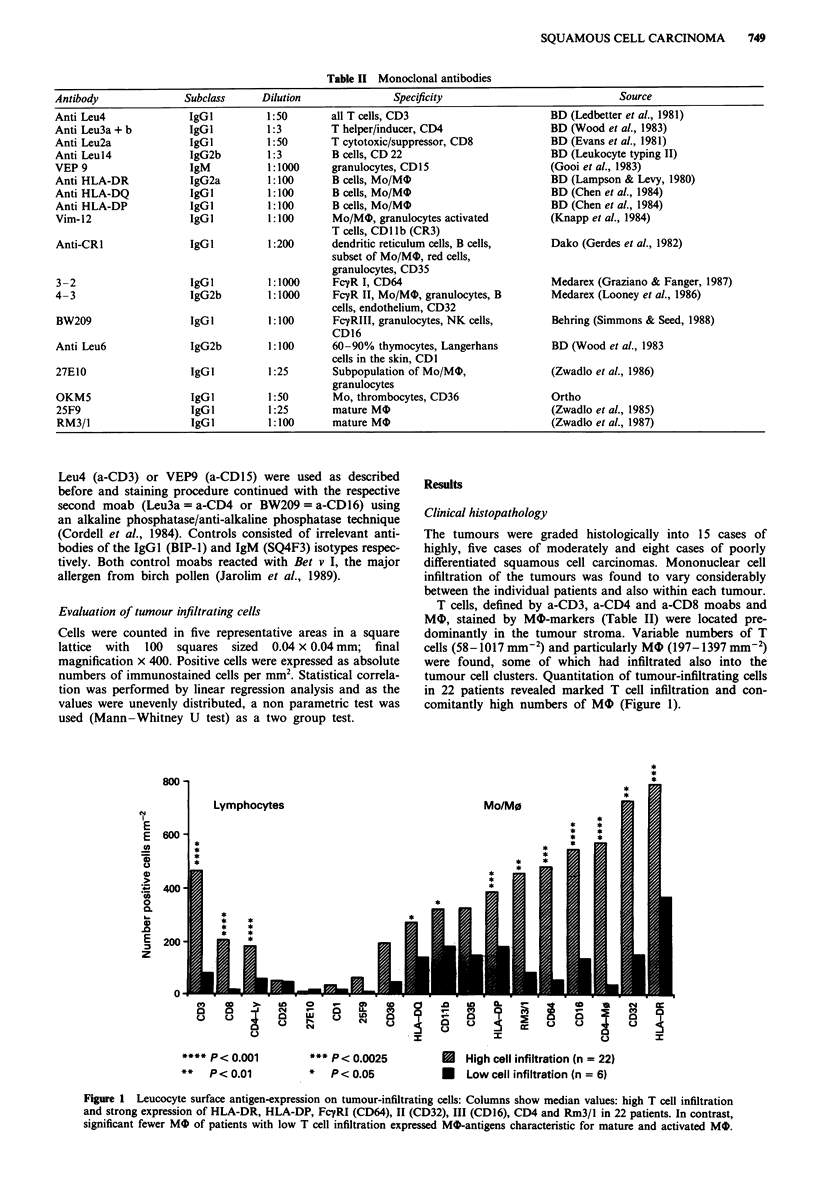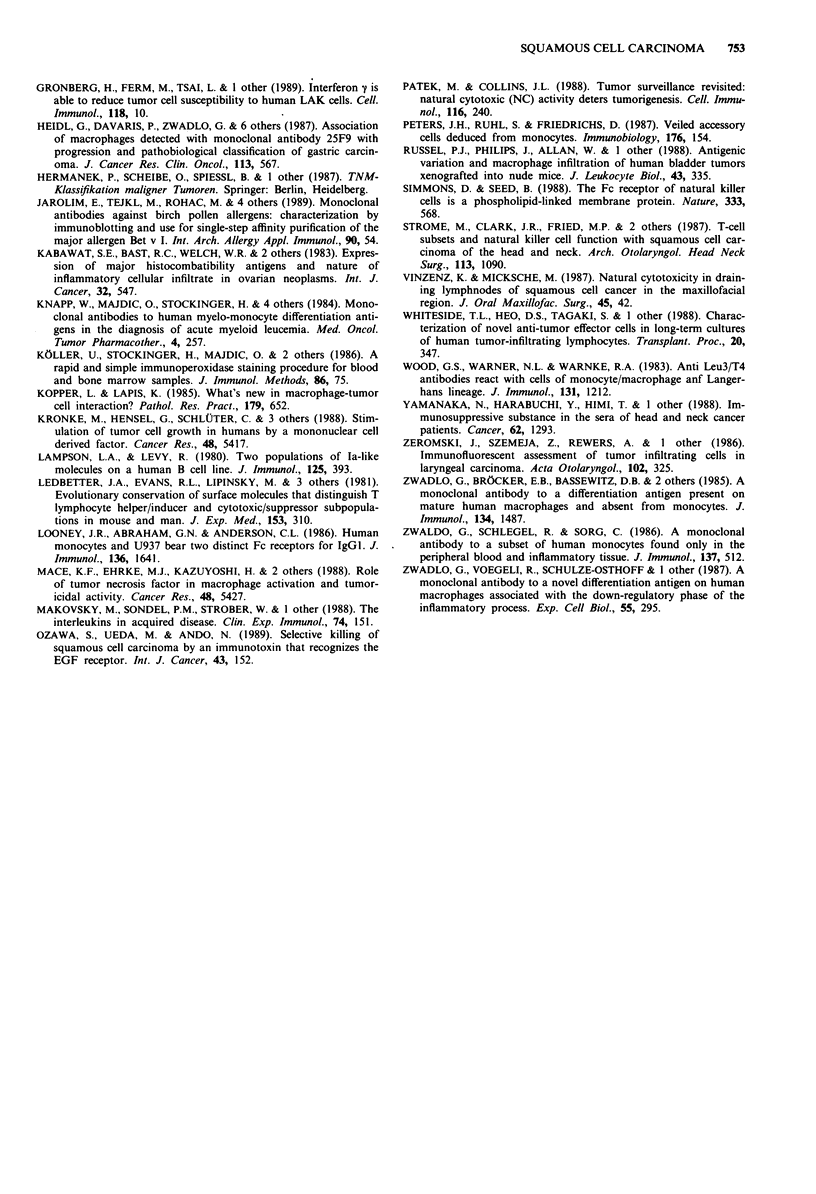Abstract
Biopsies from 26 patients with advanced stage squamous cell carcinoma of the head and neck were investigated to determine the intensity of the inflammatory cellular infiltrate and the expression of leucocyte antigens. Mononuclear cell infiltration varied considerably between the individual patients and also within the tumour. Tumour-infiltrating cells consisted mainly of T lymphocytes and monocytes (Mo)/macrophages (M phi). Staining procedure with monoclonal antibodies (moabs) against Mo/M phi revealed different clusters of antigen expression: (1) moabs 27E10 and a-CD35 detected a subgroup of Mo/M phi with particular staining of perivasal Mo; (2) moab a-CD1 stained preferentially cells in tumour cell clusters; (3) moabs that reacted with cells of either typical M phi or dendritic morphology throughout the tumour-tissue: a-Fc gamma receptor I-III, a-class II antigens, a-CD4, Rm3/1, a-CD36 and 25F9. Thus, the majority of tumour-infiltrating mononuclear phagocytes were found to possess a rather mature phenotype. The number of Mo/M phi with mature phenotype within the tumours correlated with T lymphocyte infiltration in the tissue.
Full text
PDF





Images in this article
Selected References
These references are in PubMed. This may not be the complete list of references from this article.
- Baumgartner I., Scheiner O., Holzinger C., Boltz-Nitulescu G., Klech H., Lassmann H., Rumpold H., Förster O., Kraft D. Expression of the VEP13 antigen (CD16) on native human alveolar macrophages and cultured blood monocytes. Immunobiology. 1988 Jul;177(3):317–326. doi: 10.1016/S0171-2985(88)80050-0. [DOI] [PubMed] [Google Scholar]
- Bendtzen K. Interleukin 1, interleukin 6 and tumor necrosis factor in infection, inflammation and immunity. Immunol Lett. 1988 Nov;19(3):183–191. doi: 10.1016/0165-2478(88)90141-1. [DOI] [PubMed] [Google Scholar]
- Bröcker E. B., Zwadlo G., Holzmann B., Macher E., Sorg C. Inflammatory cell infiltrates in human melanoma at different stages of tumor progression. Int J Cancer. 1988 Apr 15;41(4):562–567. doi: 10.1002/ijc.2910410415. [DOI] [PubMed] [Google Scholar]
- Burchett S. K., Weaver W. M., Westall J. A., Larsen A., Kronheim S., Wilson C. B. Regulation of tumor necrosis factor/cachectin and IL-1 secretion in human mononuclear phagocytes. J Immunol. 1988 May 15;140(10):3473–3481. [PubMed] [Google Scholar]
- Böheim K., Denz H., Böheim C., Glassl H., Huber H. An immunohistologic study of the distribution and status of activation of head and neck tumor infiltrating leukocytes. Arch Otorhinolaryngol. 1987;244(2):127–132. doi: 10.1007/BF00458563. [DOI] [PubMed] [Google Scholar]
- Chen Y. X., Evans R. L., Pollack M. S., Lanier L. L., Phillips J. H., Rousso C., Warner N. L., Brodsky F. M. Characterization and expression of the HLA-DC antigens defined by anti-Leu 10. Hum Immunol. 1984 Aug;10(4):221–235. doi: 10.1016/0198-8859(84)90088-0. [DOI] [PubMed] [Google Scholar]
- Clarkson S. B., Ory P. A. CD16. Developmentally regulated IgG Fc receptors on cultured human monocytes. J Exp Med. 1988 Feb 1;167(2):408–420. doi: 10.1084/jem.167.2.408. [DOI] [PMC free article] [PubMed] [Google Scholar]
- Cordell J. L., Falini B., Erber W. N., Ghosh A. K., Abdulaziz Z., MacDonald S., Pulford K. A., Stein H., Mason D. Y. Immunoenzymatic labeling of monoclonal antibodies using immune complexes of alkaline phosphatase and monoclonal anti-alkaline phosphatase (APAAP complexes). J Histochem Cytochem. 1984 Feb;32(2):219–229. doi: 10.1177/32.2.6198355. [DOI] [PubMed] [Google Scholar]
- Crowe S., Mills J., McGrath M. S. Quantitative immunocytofluorographic analysis of CD4 surface antigen expression and HIV infection of human peripheral blood monocyte/macrophages. AIDS Res Hum Retroviruses. 1987 Summer;3(2):135–145. doi: 10.1089/aid.1987.3.135. [DOI] [PubMed] [Google Scholar]
- Evans R. L., Wall D. W., Platsoucas C. D., Siegal F. P., Fikrig S. M., Testa C. M., Good R. A. Thymus-dependent membrane antigens in man: inhibition of cell-mediated lympholysis by monoclonal antibodies to TH2 antigen. Proc Natl Acad Sci U S A. 1981 Jan;78(1):544–548. doi: 10.1073/pnas.78.1.544. [DOI] [PMC free article] [PubMed] [Google Scholar]
- Fidler I. J., Schroit A. J. Recognition and destruction of neoplastic cells by activated macrophages: discrimination of altered self. Biochim Biophys Acta. 1988 Nov 15;948(2):151–173. doi: 10.1016/0304-419x(88)90009-1. [DOI] [PubMed] [Google Scholar]
- Fidler I. J., Schroit A. J. Synergism between lymphokines and muramyl dipeptide encapsulated in liposomes: in situ activation of macrophages and therapy of spontaneous cancer metastases. J Immunol. 1984 Jul;133(1):515–518. [PubMed] [Google Scholar]
- Gerdes J., Naiem M., Mason D. Y., Stein H. Human complement (C3b) receptors defined by a mouse monoclonal antibody. Immunology. 1982 Apr;45(4):645–653. [PMC free article] [PubMed] [Google Scholar]
- Gooi H. C., Thorpe S. J., Hounsell E. F., Rumpold H., Kraft D., Förster O., Feizi T. Marker of peripheral blood granulocytes and monocytes of man recognized by two monoclonal antibodies VEP8 and VEP9 involves the trisaccharide 3-fucosyl-N-acetyllactosamine. Eur J Immunol. 1983 Apr;13(4):306–312. doi: 10.1002/eji.1830130407. [DOI] [PubMed] [Google Scholar]
- Graziano R. F., Fanger M. W. Human monocyte-mediated cytotoxicity: the use of Ig-bearing hybridomas as target cells to detect trigger molecules on the monocyte cell surface. J Immunol. 1987 Feb 1;138(3):945–950. [PubMed] [Google Scholar]
- Göttlinger H. G., Rieber P., Gokel J. M., Lohe K. J., Riethmüller G. Infiltrating mononuclear cells in human breast carcinoma: predominance of T4+ monocytic cells in the tumor stroma. Int J Cancer. 1985 Feb 15;35(2):199–205. doi: 10.1002/ijc.2910350210. [DOI] [PubMed] [Google Scholar]
- Heidl G., Davaris P., Zwadlo G., Jagoda M. S., Düchting S., Bierhoff E., Grüter T., Krieg V., Sorg C. Association of macrophages detected with monoclonal antibody 25 F 9 with progression and pathobiological classification of gastric carcinoma. J Cancer Res Clin Oncol. 1987;113(6):567–572. doi: 10.1007/BF00390867. [DOI] [PubMed] [Google Scholar]
- Kabawat S. E., Bast R. C., Jr, Welch W. R., Knapp R. C., Bhan A. K. Expression of major histocompatibility antigens and nature of inflammatory cellular infiltrate in ovarian neoplasms. Int J Cancer. 1983 Nov 15;32(5):547–554. doi: 10.1002/ijc.2910320505. [DOI] [PubMed] [Google Scholar]
- Knapp W., Majdic O., Stockinger H., Bettelheim P., Liszka K., Köller U., Peschel C. Monoclonal antibodies to human myelomonocyte differentiation antigens in the diagnosis of acute myeloid leukemia. Med Oncol Tumor Pharmacother. 1984;1(4):257–262. doi: 10.1007/BF02934532. [DOI] [PubMed] [Google Scholar]
- Kopper L., Lapis K. What's new in macrophage-tumor cell interaction? Pathol Res Pract. 1985 May;179(6):652–655. doi: 10.1016/S0344-0338(85)80212-0. [DOI] [PubMed] [Google Scholar]
- Krönke M., Hensel G., Schlüter C., Scheurich P., Schütze S., Pfizenmaier K. Tumor necrosis factor and lymphotoxin gene expression in human tumor cell lines. Cancer Res. 1988 Oct 1;48(19):5417–5421. [PubMed] [Google Scholar]
- Ledbetter J. A., Evans R. L., Lipinski M., Cunningham-Rundles C., Good R. A., Herzenberg L. A. Evolutionary conservation of surface molecules that distinguish T lymphocyte helper/inducer and cytotoxic/suppressor subpopulations in mouse and man. J Exp Med. 1981 Feb 1;153(2):310–323. doi: 10.1084/jem.153.2.310. [DOI] [PMC free article] [PubMed] [Google Scholar]
- Looney R. J., Abraham G. N., Anderson C. L. Human monocytes and U937 cells bear two distinct Fc receptors for IgG. J Immunol. 1986 Mar 1;136(5):1641–1647. [PubMed] [Google Scholar]
- Mace K. F., Ehrke M. J., Hori K., Maccubbin D. L., Mihich E. Role of tumor necrosis factor in macrophage activation and tumoricidal activity. Cancer Res. 1988 Oct 1;48(19):5427–5432. [PubMed] [Google Scholar]
- Malkovský M., Sondel P. M., Strober W., Dalgleish A. G. The interleukins in acquired disease. Clin Exp Immunol. 1988 Nov;74(2):151–161. [PMC free article] [PubMed] [Google Scholar]
- Ozawa S., Ueda M., Ando N., Abe O., Minoshima S., Shimizu N. Selective killing of squamous carcinoma cells by an immunotoxin that recognizes the EGF receptor. Int J Cancer. 1989 Jan 15;43(1):152–157. doi: 10.1002/ijc.2910430128. [DOI] [PubMed] [Google Scholar]
- Patek P. Q., Collins J. L. Tumor surveillance revisited: natural cytotoxic (NC) activity deters tumorigenesis. Cell Immunol. 1988 Oct 1;116(1):240–249. doi: 10.1016/0008-8749(88)90224-9. [DOI] [PubMed] [Google Scholar]
- Peters J. H., Ruhl S., Friedrichs D. Veiled accessory cells deduced from monocytes. Immunobiology. 1987 Dec;176(1-2):154–166. doi: 10.1016/s0171-2985(87)80107-9. [DOI] [PubMed] [Google Scholar]
- Russell P. J., Philips J., Allan W., Hume D. A. Antigenic variation and macrophage infiltration of human bladder tumors xenografted into nude mice. J Leukoc Biol. 1988 Apr;43(4):335–342. doi: 10.1002/jlb.43.4.335. [DOI] [PubMed] [Google Scholar]
- Simmons D., Seed B. The Fc gamma receptor of natural killer cells is a phospholipid-linked membrane protein. Nature. 1988 Jun 9;333(6173):568–570. doi: 10.1038/333568a0. [DOI] [PubMed] [Google Scholar]
- Strome M., Clark J. R., Fried M. P., Rodliff S., Blazar B. A. T-cell subsets and natural killer cell function with squamous cell carcinoma of the head and neck. Arch Otolaryngol Head Neck Surg. 1987 Oct;113(10):1090–1093. doi: 10.1001/archotol.1987.01860100068024. [DOI] [PubMed] [Google Scholar]
- Vinzenz K., Micksche M. Natural cytotoxicity in draining lymph nodes of squamous cell cancer in the maxillofacial region. J Oral Maxillofac Surg. 1987 Jan;45(1):42–47. doi: 10.1016/0278-2391(87)90084-x. [DOI] [PubMed] [Google Scholar]
- Whiteside T. L., Heo D. S., Takagi S., Herberman R. B. Characterization of novel anti-tumor effector cells in long-term cultures of human tumor-infiltrating lymphocytes. Transplant Proc. 1988 Apr;20(2):347–350. [PubMed] [Google Scholar]
- Yamanaka N., Harabuchi Y., Himi T., Kataura A. Immunosuppressive substance in the sera of head and neck cancer patients. Cancer. 1988 Oct 1;62(7):1293–1298. doi: 10.1002/1097-0142(19881001)62:7<1293::aid-cncr2820620708>3.0.co;2-d. [DOI] [PubMed] [Google Scholar]
- Zeromski J., Szmeja Z., Rewers A., Kruk-Zagajewska A. Immunofluorescent assessment of tumour infiltrating cells in laryngeal carcinoma. Application of monoclonal antibodies. Acta Otolaryngol. 1986 Sep-Oct;102(3-4):325–332. doi: 10.3109/00016488609108683. [DOI] [PubMed] [Google Scholar]
- Zwadlo G., Bröcker E. B., von Bassewitz D. B., Feige U., Sorg C. A monoclonal antibody to a differentiation antigen present on mature human macrophages and absent from monocytes. J Immunol. 1985 Mar;134(3):1487–1492. [PubMed] [Google Scholar]
- Zwadlo G., Schlegel R., Sorg C. A monoclonal antibody to a subset of human monocytes found only in the peripheral blood and inflammatory tissues. J Immunol. 1986 Jul 15;137(2):512–518. [PubMed] [Google Scholar]
- Zwadlo G., Voegeli R., Schulze Osthoff K., Sorg C. A monoclonal antibody to a novel differentiation antigen on human macrophages associated with the down-regulatory phase of the inflammatory process. Exp Cell Biol. 1987;55(6):295–304. doi: 10.1159/000163432. [DOI] [PubMed] [Google Scholar]





